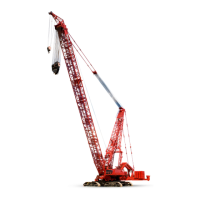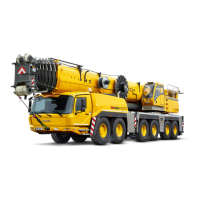INTRODUCTION 777 SERVICE MANUAL
1-10 Published 10-01-2012, Control # 045-08
pressure. When rapid loading produces pressure spikes,
system relief valve (16) shifts, allowing the high pressure oil
to be returned to tank through charge pump relief valve (3) or
transferring the oil into the low pressure side of the loop
through charge flow make-up check valve (4).
In all other system pumps (both load drums, boom, auxiliary
hoist, and swing), the pressure limiting feature of the
multifunction valve is not present. Orifices (A) in the
multifunction valve and flow control orifice (20) are removed
from the EDC. In addition, servo check valves (18) are
removed from the pump and the paths to the servo control
cylinders are plugged. These internal changes to the pump
configuration permit the pump to react more quickly to
commands from the PC.
Also in these systems, pressure limiting valves (17) function
as pilot valves to open system relief valves (16) when the
relief pressure setting is reached. For example, when a
pressure imbalance occurs on both sides of flow restrictor
(21), pressure limiting valve (17) opens and system relief
valve (16) relieves the system pressure from the circuit by
directing the oil to tank through charge pump relief valve (3)
or transferring the flow to the low pressure side of the loop
through charge flow make-up check valve (4).
Hydraulic Motors
Variable displacement low torque/high speed, bent-axis
piston motors are used in the hydrostatic transmissions of
the load drum, travel, and auxiliary hoist (optional) systems.
A fixed displacement low torque/high speed axial piston
motor is used in the hydrostatic transmission of the swing
system. Each motor contains a cylinder block, nine pistons,
output shaft flange, and loop flushing (purge) valve
assembly. The load drum motors are without a loop flushing
valve assembly since these systems have external loop
flushing valves. The load drum and auxiliary hoist (optional)
bent-axis motors are also have a pressure control pilot
(PCP) valve that serves the same basic function and
demonstrates similar operating characteristics as the pump
EDC. Each travel motor contains a pressure compensator
regulator (PCR) valve to accomplish the pressure control
function.
The cylinder block of all system motors (except swing) is
tilted at an angle to the output shaft with the pistons fitted
axially around its axis. (The swing motor is perpendicular to
the shaft.) The internal end of the output shaft has a large
flange face, which provides similar function to that of the
pump swashplate. Since the motor piston ends are retained
to the output flange face, the pistons cannot rotate around
the axis of the rotatable flange as the pump pistons do on the
stationary swashplate.
Oil entering the motor from a system pump provides force
against the motor pistons, causing the retained piston ends
to thrust against the output flange with a rotational torque
that turns the output shaft on its axis. This thrust also rotates
the cylinder block on its axis while its tilt to the flange face
reciprocates the pistons as they rotate. The oil displaced by
the pistons returns to the system pump.
All motors, excluding the swing system motor, have a servo
mechanism that tilts the cylinder block to vary the oil
displacement. Contingent upon the particular system motor,
the servo mechanism includes shuttle valve (22), servo
control valve (23), and servo cylinder (24). These servo
mechanism components initiate the motor operation for the
load drums, and auxiliary hoist (optional) at maximum
displacement. This provides maximum starting torque at a
lower speed. When the servo mechanism tilts the cylinder
block to the position of minimum oil displacement, the shaft
output speed is approximately five times faster and the
available output torque decreases to approximately one-fifth
of the maximum torque value.
The actuation of the travel motor servo mechanism is
opposite of the other system motors. The travel motors begin
operation at minimum displacement and cylinder block tilts to
maximum displacement at about 3,500 psi as the operation
commences. Servo control oil is supplied from the low
pressure line of motor port A or B and travels through shuttle
valve (22) and servo control valve (23) before entering servo
cylinder (24).
The load drum hoist motors remain in maximum
displacement until servo control valve (23) receives a
command from PCP valve (25) to direct the constant
pressure and flow from shuttle valve (22) to the minimum (or
maximum) displacement side of servo cylinder (24) which
shifts the motor. As the PCP valve opens in proportion to the
current received from the PC, pilot oil from its system charge
pump is directed to shift servo control valve (23). After
overcoming adjustable valve spring (26) and valve spring
(27), which is preset by the cylinder block tilt angle, servo
control valve (23) shifts and directs pressurized oil to stroke
the motor into minimum displacement output. If the load on
the motor increases, the cylinder block force on adjustable
valve spring (26) increases. This forces servo control valve
(23) to destroke the motor to maximum displacement for safe
load handling.
Load drum circuits also have pressure compensated over-
ride (PCOR) system valve (28) which activates at a preset
pressure of 4,930 psi (340 bar). When increasing system
pressure exceeds the PCOR setting, PCOR valve (28) shifts
to direct oil flow from shuttle valve (22) into the maximum
displacement side of servo cylinder (24). PCOR valve (28)
over-rides the command from servo control valve (23),
causing an increase in motor displacement and output
torque and a reduction in output speed. When PCOR valve
(28) closes, the control of the motor returns to servo control
valve (23).
All hydraulic motors have case oil drainage that lubricates
the motors and provides a source of for continuous
recirculation of the oil supply to control heat generation in the

